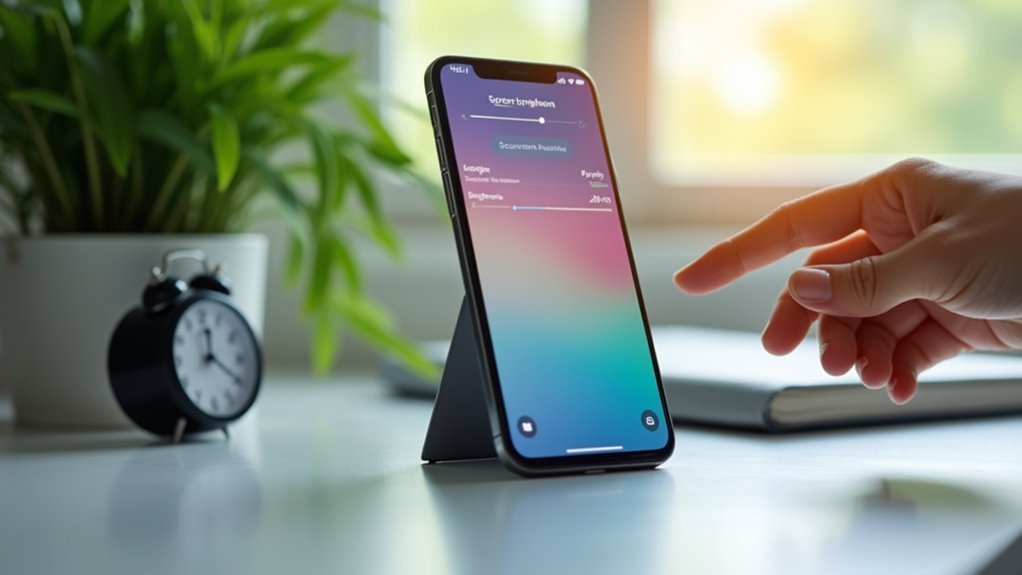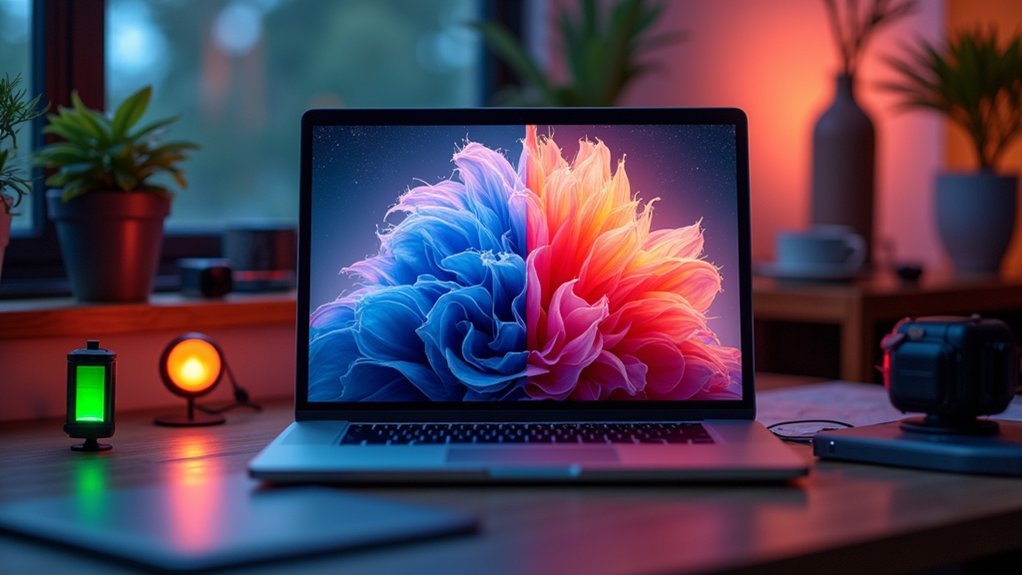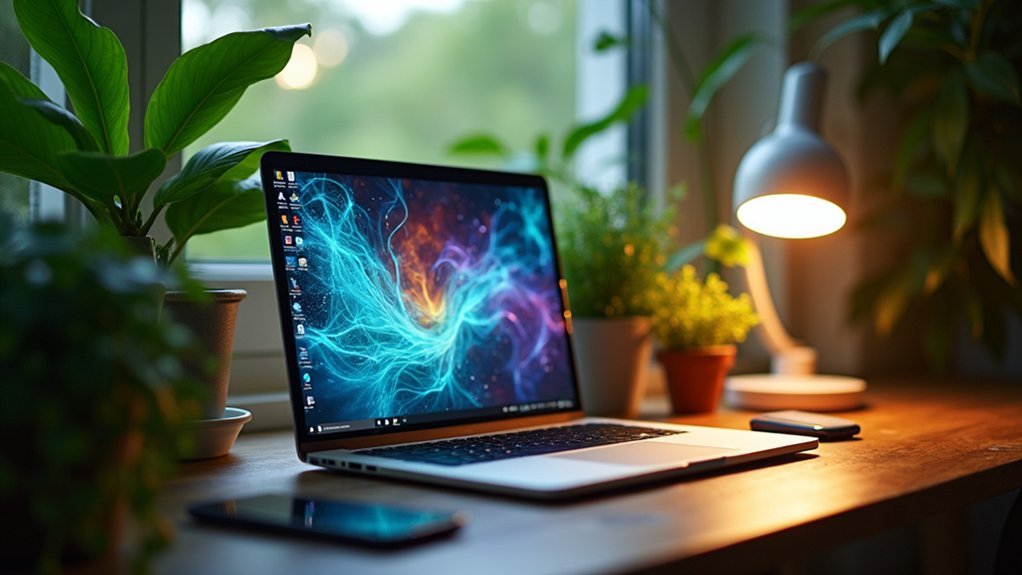You can optimize graphics without draining your battery by adjusting display brightness to at least 250 nits and using shorter screen timeout settings. Enable power-efficient GPU modes like NVIDIA’s “Ideal Power” setting and use integrated graphics for basic tasks. Disable visual effects and transparency, switch to dark themes, and lower in-game graphics settings. Configure background apps to limit resource usage and implement smart power profiles that automatically adjust performance based on your battery level for maximum efficiency.
Adjust Display Brightness and Screen Timeout Settings

Display brightness consumes more battery power than almost any other component on your device.
You’ll want to adjust display brightness to at least 250 nits for efficiency while lowering it during non-essential tasks. Configure your power settings to establish shorter screen timeout settings, reducing active display time when idle to conserve battery effectively.
Use function keys to manually control brightness in low-light environments, markedly cutting power consumption.
Apply dark themes since darker colors reduce energy use on certain displays. Disable automatic brightness adjustments to prevent unnecessary fluctuations that drain battery faster.
Remove any unnecessary background processes that affect display performance.
These screen timeout settings and brightness controls help optimize graphics while extending battery life through strategic power consumption management.
Enable Power-Efficient Graphics Modes and GPU Management
When you’re running graphics-intensive applications, your GPU becomes one of the largest power consumers on your device. Proper GPU management and power-efficient graphics modes can greatly improve battery life without sacrificing essential functionality.
Here are four key strategies for reducing battery consumption:
- Enable integrated graphics for basic tasks instead of your discrete GPU, as they consume considerably lower power.
- Adjust power management settings in NVIDIA Control Panel to “Ideal Power” mode for dynamic performance scaling.
- Utilize NVIDIA Optimus technology to automatically switch between integrated and discrete graphics based on workload demands.
- Lower in-game graphics settings and resolution to reduce GPU load during gaming sessions.
Regular driver updates guarantee ideal power management capabilities, delivering battery saving improvements through enhanced energy efficiency algorithms.
Optimize Visual Effects and Animation Settings

Beyond GPU hardware management, you’ll find that Windows’ built-in visual effects and animations continuously consume system resources in the background.
To optimize these settings, navigate to System Properties > Advanced > Performance Settings and select “Adjust for best performance” to minimize power-hungry animations. You’ll also want to disable transparency effects through Settings > Ease of Access > Display to reduce GPU power consumption.
Lower your display brightness and consider switching to dark mode, which considerably decreases power usage on OLED screens.
Additionally, reduce your display resolution and refresh rate in display settings, as these directly impact battery life. For gaming, optimize in-game animation settings by lowering detail levels and turning off shadows.
These adjustments collectively reduce power draw while maintaining acceptable visual quality.
Configure Background App Activity and Resource Allocation
While adjusting display and animation settings provides immediate power savings, managing background applications offers another layer of battery optimization that works hand-in-hand with graphics performance.
You can markedly reduce power draw by controlling which apps run behind the scenes.
Here’s how to configure background activity effectively:
- Monitor battery usage per app through Windows settings to identify resource-hungry applications and disable background apps that aren’t essential.
- Use Task Manager to disable non-essential startup programs that unnecessarily consume power during boot and operation.
- Adjust Windows Power Settings to limit background activity for specific applications, ensuring only necessary processes run during battery mode.
- Set apps to use integrated graphics instead of discrete graphics when high performance isn’t required, and manage sync settings to extend battery life.
Implement Smart Power Management Profiles

After configuring background applications, you’ll want to establish smart power management profiles that automatically adjust your system’s performance based on current needs and battery levels. Navigate to Settings > System > Power & battery to customize your power plan settings.
| Setting | Battery Optimization |
|---|---|
| CPU Core performance | Reduce to use less power |
| Display | Change brightness automatically |
| Graphics switching | Enable discrete graphics only when needed |
| Background apps | Limit activity in Battery Saver mode |
Enable Battery Saver mode to automatically restrict high-power features when your battery reaches critical levels. Access Nvidia Control Panel to configure Optimus technology, allowing seamless switching between integrated and dedicated graphics card options. These profiles guarantee your graphics remain optimized while helping your battery last considerably longer during demanding tasks.
Frequently Asked Questions
Does High Graphics Drain Battery?
Yes, high graphics settings considerably drain your battery. You’ll experience 10-15W power consumption compared to 2-3W on lower settings. Your laptop’s discrete GPU consumes more power than integrated graphics, reducing battery life substantially.
How to Turn off GPU to Save Battery?
You can disable your dedicated GPU through Device Manager to save battery. Right-click your GPU, select “Disable device,” and your laptop’ll switch to integrated graphics, reducing power consumption considerably.
How to Optimize a Gaming Laptop for Long Battery Life?
You’ll maximize battery life by enabling power-saving mode, lowering screen brightness, disabling unnecessary background apps, using integrated graphics instead of discrete GPU, reducing CPU performance settings, and closing unused programs while gaming.
Does Lowering Graphics Reduce Battery Usage?
Yes, you’ll greatly reduce battery usage by lowering graphics settings. When you decrease resolution, disable anti-aliasing, and turn off shadow effects, your GPU works less hard, consuming less power and extending battery life.





Leave a Reply